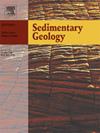Origin and deposition of deepwater homogenites from a sedimentological perspective: Examples from offshore SW Taiwan
IF 2.9
2区 地球科学
Q1 GEOLOGY
引用次数: 0
Abstract
A giant piston core, MD18–3548 (20.07 m) was collected from a perched basin in the Taiwan accretionary wedge, at a water depth of 1752 m. Detailed grain-size analysis, 14C accelerator mass spectrometry (AMS) dating, and computed tomography (X-CT) scans of the core were performed. Four types of lithofacies, namely hemipelagic sediments, silty turbidite-homogenites, turbidites, and thin silty layers, are identified, along with seventeen event beds. A total of fourteen 14C AMS dating were carried out, with the depositional ages of the event beds being calculated based on the sedimentation rate of hemipelagites. The oldest event bed is ∼12 cal kyrs BP, while the youngest event bed is ∼64 cal yrs BP. All seven homogenite units are floored by a thin (usually <10 cm thick), coarsening-upward first and then fining-upward unit, capped by a thick structureless mud totally devoid of bioturbation. The average thickness of homogenite units is ∼150 cm, while the thickest homogenite unit is ∼200 cm. These homogenite units can be compared to similar deposits reported elsewhere and find particularly that these units exhibit a basal layer with gradual coarsening and fining upward trend in grain size. We therefore propose a new depositional model for the silty turbidite-homogenite units in seismically-shaken enclosed basins. This model takes into account the coarsening-then-fining upward deposition of the basal layers, reported for the first time.
沉积学视角下深水均质岩的成因与沉积:以台湾西南近海为例
一个巨大的活塞岩心MD18-3548 (20.07 m)采集自台湾吸积楔的一个栖息盆地,水深1752 m。对岩心进行了详细的粒度分析、14C加速器质谱(AMS)测年和计算机断层扫描(X-CT)扫描。发现了半深海沉积、粉质浊积-均质岩、浊积岩和粉质薄层4种岩相类型,以及17个事件层。共进行了14次14C AMS测年,并根据半玄武岩的沉积速率计算了事件层的沉积年龄。最古老的事件层年龄为~ 12 calyrs BP,而最年轻的事件层年龄为~ 64 calyrs BP。所有7个均质岩单元都是由一层薄的(通常为10厘米厚),先变粗再变细的单元覆盖,顶部是一层厚的无结构泥浆,完全没有生物扰动。均质岩单元的平均厚度为~ 150 cm,而最厚的均质岩单元为~ 200 cm。这些均质岩单元可以与其他地方报道的类似矿床进行比较,并特别发现这些单元具有逐渐粗化和细化的基底层,其粒度呈上升趋势。因此,我们提出了一种新的地震震陷封闭盆地粉质浊积岩-均质岩单元沉积模式。该模型考虑了首次报道的基底层先变粗后变细的向上沉积。
本文章由计算机程序翻译,如有差异,请以英文原文为准。
求助全文
约1分钟内获得全文
求助全文
来源期刊

Sedimentary Geology
地学-地质学
CiteScore
5.10
自引率
7.10%
发文量
133
审稿时长
32 days
期刊介绍:
Sedimentary Geology is a journal that rapidly publishes high quality, original research and review papers that cover all aspects of sediments and sedimentary rocks at all spatial and temporal scales. Submitted papers must make a significant contribution to the field of study and must place the research in a broad context, so that it is of interest to the diverse, international readership of the journal. Papers that are largely descriptive in nature, of limited scope or local geographical significance, or based on limited data will not be considered for publication.
 求助内容:
求助内容: 应助结果提醒方式:
应助结果提醒方式:


